I was lying in bed this morning, as it is my day off, when I heard the email ping of my iPhone.
In case you aren’t a long-time reader of this blog, I changed careers to become a salesperson, at the largest Chevrolet dealer in the world, because of my love for the Chevy Volt.
The email had been sent by my manager (and the guy who went out on a limb to hire me), Hank Gaylor. Hank had received an email from his father, after his father had seen a story claiming it took $18 to fill a Volt’s battery from empty. Here’s what Hank’s dad saw: (my added comments in red)
As a “joke”, my Chev dealer gave me a Volt as a loaner while my full-size pick-up was getting some attention. He thought it was funny to give his energy company CEO (emphasis added) this thing here on Vancouver Island! I live 30 kilometers outside of Victoria near Sidney.
The battery was dead – later he admitted they almost never charged it. While the car was “OK”, on gasoline, it was pretty anemic. So for the extra money, even taking into account Chev rebates and Provincial incentives, you get an under-powered, heavy car that felt “too small” for its actual size (battery has to go somewhere). “Underpowered”? PLEASE! I regularly out-accelerate 5-series BMW’s and pickups don’t stand a chance, against my Volt
Now the kicker: at a neighborhood barbecue, I was talking to a Neighbor, a BC Hydro executive. I asked him how that renewable thing was doing. He laughed, then got serious. If you really intend to adopt electric vehicles, he pointed out, you had to face certain realities. For example, a home charging system for a Tesla requires 75 amp service. I don’t know about Telsa’s charging requirements, but we have two 240V chargers, at our home. Each is on it’s own 30 amp circuit. Our A/C unit is on a 45 amp circuit. Perhaps Canada just recently started experimenting with electric service in their homes…
The average house is equipped with 100 amp service. So in Canada, I could have A/C, an electric oven and a few lights/electric outlets in use at the same time??? On our small street (approximately 25 homes), the electrical infrastructure would be unable to carry more than 3 houses with a single Tesla, each. Do Canadians have to take turns, with their neighbors, for cooking? watching TV? For even half the homes to have electric vehicles, the system would be wildly over-loaded.
This is the elephant in the room with electric vehicles … Our residential infrastructure cannot bear the load. We have ample delivery in the U.S. of A., but it still needs updating. Smart grid is being deployed here. So as our genius elected officials ram this nonsense down our collective throats, not only are we being forced to buy the damn things and replace our reliable, cheap generating systems with expensive, new windmills and solar cells, but we will also have to renovate our entire delivery system! This latter “investment” will not be revealed until we’re so far down this dead end road that it will be presented with an oops and a shrug. Oddly enough, there is no fuel cost to renewable energy plants, but you keep paying for coal, natural gas, uranium, etc FOREVER!
If you want to argue with a green person over cars that are Eco-friendly, just read the below:
Note: However, if you ARE the green person, read it anyway. Enlightening. This is a parody, right? Did they get it from The Onion??? (The Onion is a news parody site.)
Eric test drove the Chevy Volt at the invitation of General Motors…and he writes…For four days in a row, the fully charged battery lasted only 25 miles before the Volt switched to the reserve gasoline engine. He must have been driving through two feet of snow, UPHILL THE WHOLE WAY, on flat tires, towing a boat.
Eric calculated the car got 30 mpg including the 25 miles it ran on the battery. “Eric is an “energy company CEO???” I won’t be calling him if I find a math error in my bill! So, the range including the 9 gallon gas tank and the 16 kWh battery is approximately 270 miles. Actual Volt range is 370 miles (1st generation Volt 2011-2015) and 440 miles (2nd generation Volt 2016+)
It will take you 4 1/2 hours to drive 270 miles at 60 mph. Then add 10 hours to charge the battery and you have a total trip time of 14.5 hours. Why not charge the Volt while you sleep, the night before you leave and charge again, while you sleep, after your arrival? Also, why not use a 240V fast charger (I have two, myself) and reduce charge time to 4 hours? In a typical road trip your average speed (including charging time) would be 20 mph. If you used the slowest charger possible and charged during your drive, instead of taking my advice above. Then again, on long road trips, I treat my Volt like any other car, just running on gasoline and only charging at the hotels.
According to General Motors, the Volt battery holds 16 kWh of electricity. It takes a full 10 hours to charge a drained battery. The cost for the electricity to charge the Volt is never mentioned so I looked up what I pay for electricity. I pay approximately (it varies with amount used and the seasons) $1.16 per kWh. If that’s really what Canadians pay for electricity, my average monthly electric bill there (1,980 kWh per month) would be $2,297. Yes, PER MONTH! 16 kWh x $1.16 per kWh = $18.56 to charge the battery. For these calculations, and to address both generations of the Chevy Volt so far, see my comments below.
$18.56 per charge divided by 25 miles = $0.74 per mile to operate the Volt using the battery. Compare this to a similar size car with a gasoline engine that gets only 32 mpg. $3.19 per gallon divided by 32 mpg = $0.10 per mile.
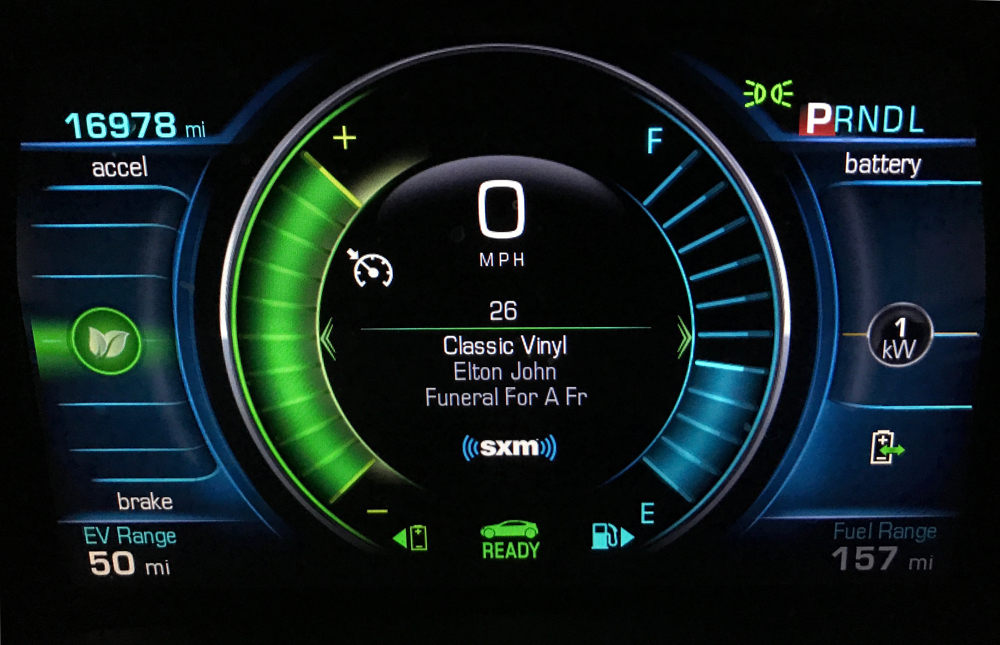
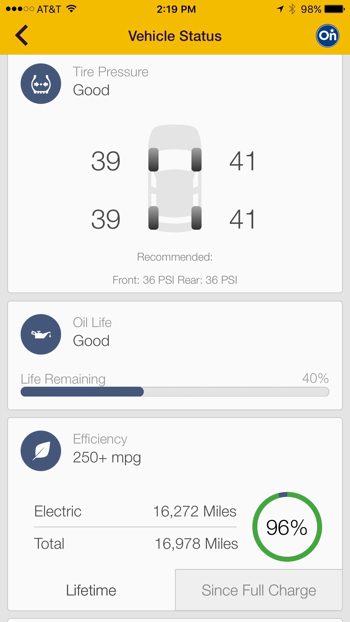
The gasoline powered car costs about $15,000 while the Volt costs $46,000 No, MSRP is $34K (LT) to $39,500K (loaded Premier, no navigation, no $1K pearl paint). After you deduct the $7,500 Federal Income Tax Credit for a Volt purchase, it has dropped to $26,500 to $32,000. The Chevy Cruze Hatchback is close in size and functionality to the Volt, since the Volt & Cruze started on the same platform. It is also good for this example, as it gets 32 MPG average, as this Canadian uses as his example.
A Chevy Cruze Hatchback (LT, with remote start) lists for $24K ($2,500 less than an LT Volt). A Chevy Cruze Hatchback (Premier, without sunroof or navigation) lists for $27,500K ($4,500 less than the Volt (Premier, without sunroof or navigation). ……..So the American Government wants proud and loyal Americans not to do the math, but simply pay 3 times as much for a car No, it’s 10% more for the LT and 16% more for the Premier, that costs more than 7 times as much to run, and takes 3 times longer to drive across the country….. Again, if treated like a gas car, your travel time is exactly the same as any other gas car. Oil changes on a Volt, typically are done every 1-1/2 to 2 years, depending on gas engine usage. Try that on a gasoline-powered car! There’s a savings there, but wait! There’s more!
The Cruze gets 32 MPG (average) and has a range of 397 (city) to 520 miles (highway). The Volt has a 440 mile range (full battery and gas tank) and gets 42 MPG (on gasoline) and 82 MPG (on electricity, see below). Using my real world experience, over the 16,978 miles I’ve driven so far, I have bought about 18 gallons to go 706 miles (see image above) for an average of 39.2 MPG on gasoline. On electricity, I’ve driven 16,272 miles. Yes, I can charge for free at work and at many locations in the DFW area, but for the sake of argument, let’s say I paid for all the electricity I’ve put in my Volt, my cost of electricity for driving 16,272 miles is less than $400. That works out to a dollar equivalent of 96.8 MPG (dollar equivalent at current gas price) on electricity! ($400 ÷ $2.38 = 168 gallons. 16,272 miles ÷ 168 gallons = 96.8 MPG equivalent). Those same miles in a Cruze would have required 530.5 gallons of gas, at a cost of $1,263! Over the time I’ve owned my Volt, I have saved at least $820. That’s over 439 days of ownership. Over just one year that would be $682 saved per year. At that rate, break even on ownership is 6.6 years. Once you include the reduced frequency of oil changes in a Volt, break even is about 6 years, or the finance term used by most Americans, when purchasing a new car. The Volt is a far better car than the Cruze (which I like very much) and at 6 years, they cost about the same. After that point though, I save $682 per year by owning the Volt, as mentioned above.
**DISCLAIMER** In actuality, I only pay for about half of the electricity my Volt uses, since I charge for free, like many Volt drivers, at my job or when I find a free charging station. By the way, how many times have you found a free gasoline station? 
The error, in the math provided by the Canadian above, is in the cost of electricity and how much it takes to fill the battery. Here’s how it really works:
NO ONE pays $1.16 per kWh. Average, in the U.S. is $0.11, or 11 CENTS per kWh. This should be shown as $0.11. Many Texans pay less than 9 cents per kWh. I’ll bet the person in the story meant to say 11.6 CENTS per kWh (or heaven help Canada!).
The 1st gen Volt battery had 16 KWh of storage, but you were never allowed to use all of it. Lithium Ion batteries should never be completely drained or filled. The 1st gen Volt allowed only 10.8 kWh to be used. Some electricity is lost in the transfer and the Volt runs fans (and sometimes A/C) to keep the battery in a good temperature range while charging. I averaged 12.8 kWh to fill the battery from “empty,” in our 2012 Volts, accounting for fans and transfer loss. Filling the battery 12.8 kWh X 11.6 CENTS ($0.116) = $1.48 per full charge, not $18.56 as this guy states above.
Once filled, the 1st gen battery, on average, would go 38 miles on a charge, NOT 25. $1.48 ÷ 38 miles = 3.9 CENTS ($0.039) per mile. Currently (pun intended), with gas in the U.S. averaging $2.38 per gallon (last month’s average), that’s the dollar equivalent of 61 MPG. ($2.38 ÷ $0.039)
HOWEVER: if you pay 8.6 cents per kWh, like I do, it only cost $1.10 for a full charge of a 1st gen Volt. $1.10 ÷ 38 miles = 2.9 CENTS ($0.029) per mile, which is the equivalent of 82 MPG. If gasoline prices rise, the Volt’s MPGe (dollar equivalent just gets better and better).
I personally have gotten as much as 52.7 miles on a single charge in my 1st generation Volt (2012, see image), but that’s not average. However, on that day, I got the dollar equivalent of 115 MPG.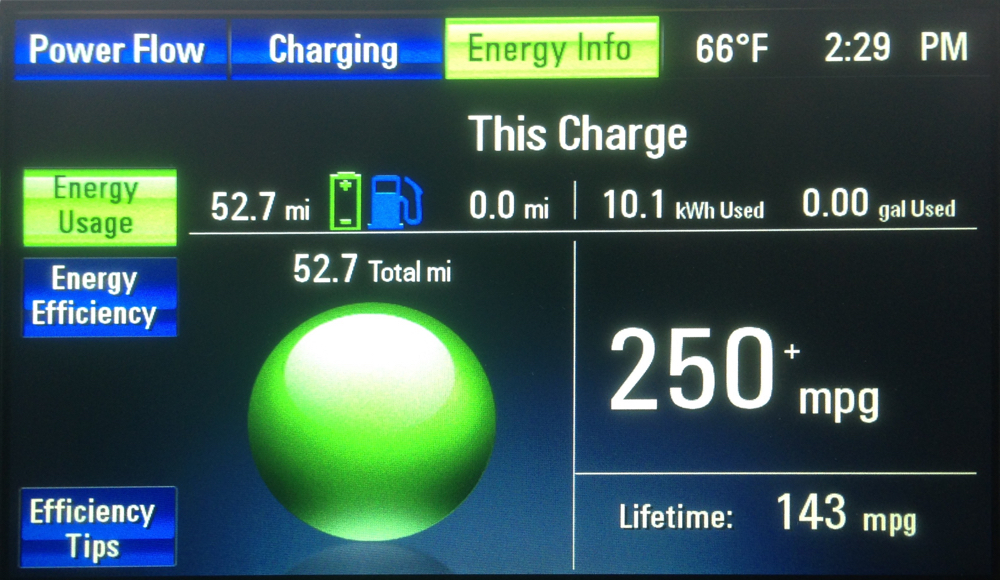 The 2nd generation Volt goes an average of 53 miles per charge, with a lighter battery with only 2/3 as many battery cells. However, it stores 18.4 kWh, of which 16 kWh is useable add 2 kWh, for cooling during charging, and you get 18 kWh per 53 miles. Using the math outlined above, it gets the average dollar equivalent of 60.4 MPG (11.6 CENTS per kWh) or 81.4 MPG (at 8.6 CENTS per kWh, like I pay).
The 2nd generation Volt goes an average of 53 miles per charge, with a lighter battery with only 2/3 as many battery cells. However, it stores 18.4 kWh, of which 16 kWh is useable add 2 kWh, for cooling during charging, and you get 18 kWh per 53 miles. Using the math outlined above, it gets the average dollar equivalent of 60.4 MPG (11.6 CENTS per kWh) or 81.4 MPG (at 8.6 CENTS per kWh, like I pay).
Not only does the Volt get fantastic gas mileage, it is very fast off the line. It is so silent, GM installs low speed noise makers (or pedestrians would get run over in parking lots). It generates ZERO pollution while doing so. If you get your electricity from renewable sources, like I do (wind generated from Green Mountain Energy and solar panels on our house), even the creation of the electricity you use generates ZERO pollution!
We have 3 Volts, in our household. If the example you presented were correct, it would have bankrupted us! THIS KIND OF B.S. HAS BEEN PRESENTED BY CONSERVATIVE MEDIA AND OIL COMPANIES, SINCE THE VOLT CAME OUT. I BATTLE IT EVERY DAY. I can’t blame them. They’re just trying to survive. I just hope people stop falling for this bullshit. (Texas term. NOT cussing!)
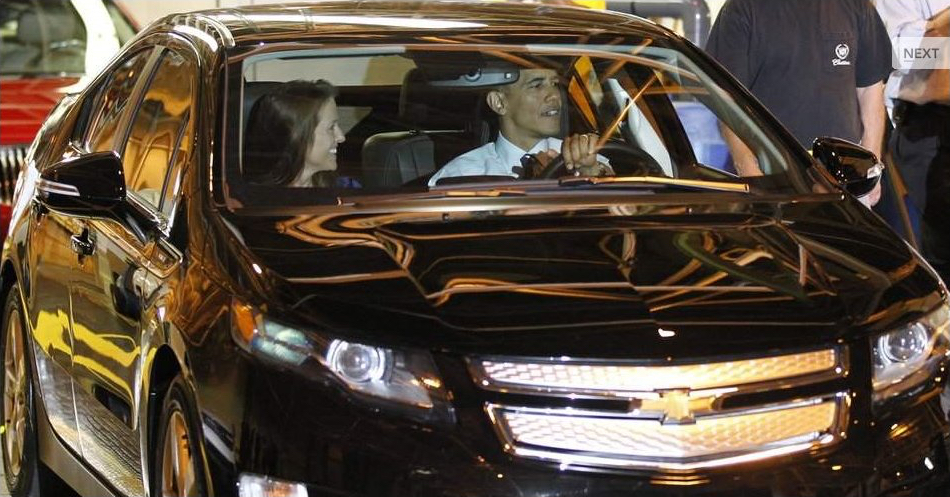

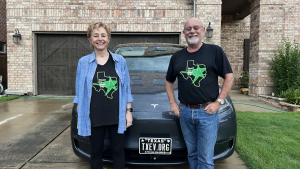

Oh man that takes me back!
My uncle was convinced by Fox News that my Spark battery was going to degrade and need replacing in just a few years, that my Volt was going to catch fire and burn down our apartment, and that the batteries and power plant emissions were worse for the environment than the Scion I replaced. So many idiotic facebook likes / shares directed at me.
All of which was complete BS. Now Fox actually seems to like the Bolt and new Volt…
http://www.foxnews.com/auto/2017/04/07/2017-chevrolet-bolt-review.html
Now that all car makers have plug-ins, I hope this anti-EV propaganda will become a thing of the past!